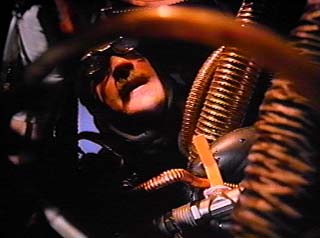|

Office machinery in Brazil looks simultaneously
futuristic and old-fashioned.
This is essentially the world of Brazil (minus the "safe" and "satisfactory," at least as far as Sam is concerned). The film gives us a simultaneous past and present; its gadgets of the future (the computer consoles…) simply echo the gadgets of the past (…look like old-fashioned typewriters). Gilliam does this to show the uncontrollable nature of optimistic fantasy in the face of pessimistic modernity (with its principal objective to achieve a total and rational organization of modern life).10 In the end, because of the indistinguishable past/future combination, "Somewhere in the 20th Century" becomes "Everywhere," and "Someday soon…" becomes "never."
Yet, there is still another way of looking at this conundrum. Before the subtitle "Somewhere in the 20th Century" (still an undetermined space), Gilliam uses one which reads "8:49 p.m." (a specific time). This exact moment brings a new dimension to the interpretation above. The "timeless present" now exists in one precise moment. Gilliam himself admitted that he wanted the architectural look of the film to evoke neither the past nor the future, but the world as it would look if the whole century had been compacted into a single moment ("8:49 p.m." the "timeless present").11

The walls are filled with ducts of every variety in Brazil.
In an original way, Gilliam proves the absurdity of modernity (the illogic of the logical). Recalling Baudelaire’s definition of modernity, Gilliam shows what would happen if it were possible to have one half eternal ("8:49 p.m.") and the other half transitory and fugitive ("Somewhere [or as demonstrated above "Everywhere"] in the 20th Century") — and gives us results that point to Sam's self-destruction. This is why Sam does, and does not, escape. "Someday soon…" is within his grasp, but because modernity is always one step ahead of its human counterparts, "Someday soon…" will never come.
It is also possible to see Brazil’s simultaneous past/future makeup in the images and music Gilliam selects (as opposed to just the words). While the above discussion basically deals with the philosophical tenets of postmodernism, the movie’s visual dimension is more concerned with style. As a style, "[postmodernism] emphasizes diversity, displays a penchant for pastiche, and advocates eclectic use of elements from the past."12 Although Brazil is meant to be futuristic in some sense, it incorporates several cultural artifacts, in particular elements from the late ‘30s and early ‘40s. The workers watch Casablanca (1942) and B westerns on their mini-TV/computer screens; the costumes are vintage Hollywood fashions from the ‘30s and ‘40s; the large eagle statue at the entrance of the Ministry of Information symbolically recalls the Nazi domination of the late ‘30s/early ‘40s, as do the scenes in which armor-clad police burst into apartments (Buttle’s and later Sam’s mother’s) like SS troops; the various posters in the film ("Don’t Suspect a Friend – Report Him!") copy the style of those World War II posters designed by the Englishman Abram Games; and finally, even the title song "Brazil" by Xavier Cugat comes from 1939.13

A large eagle statue dominates the entrance to the
Ministry of Information in Brazil.
To the idle viewer, all of this may seem like mere coincidences, but Gilliam strategically designs his film to recall the writing of Arnold Toynbee. According to Toynbee, the "second act" of the "first postmodern general war in AD 1914, brought into focus a series of problems with the rapidity of technological change…in so far as [it] threatened prevailing forms of life…"14 Put another way, "World War II, with its unprecedented savageness and destruction, with its revelation of the brutality at the core of a high-technological civilization, could appear as the culmination of demonic modernity, a modernity that has finally been overcome."15 Overcome, quite simply, by the advent of postmodernism. Thus, is it any wonder that Gilliam created Brazil to look like that moment in history that best exemplifies the evils of modernity and the beginning of those styles associated with postmodernism?
page 3 of 4
 
© Keith James Hamel
photo credits: MCA Universal Home Video
|







